| کد مقاله | کد نشریه | سال انتشار | مقاله انگلیسی | نسخه تمام متن |
|---|---|---|---|---|
| 6446190 | 1640804 | 2015 | 13 صفحه PDF | دانلود رایگان |
عنوان انگلیسی مقاله ISI
Nile behaviour and Late Palaeolithic humans in Upper Egypt during the Late Pleistocene
ترجمه فارسی عنوان
رفتار نیل و انسانهای اواخر ایلئولیت در مصر بالا در طول پیلوستاکین پسین
دانلود مقاله + سفارش ترجمه
دانلود مقاله ISI انگلیسی
رایگان برای ایرانیان
کلمات کلیدی
موضوعات مرتبط
مهندسی و علوم پایه
علوم زمین و سیارات
زمین شناسی
چکیده انگلیسی
In this paper we summarize the evidence thus far available for the Late Pleistocene on the population densities in the Nile Valley, and on the models of Nilotic behaviour. In the discussion we include data on the environmental conditions in Eastern Africa, on the aeolian processes in the Western Desert of Egypt derived from satellite images, 14C and OSL dates, in order to formulate a new model that explains the observed high remnants of aeolian and Nilotic deposits and the related Late Palaeolithic sites. This model hypothesizes that, during the Late Pleistocene, and especially the LGM, dunes from the Western Desert invaded the Nile Valley at several places in Upper Egypt. The much reduced activity of the White Nile and the Blue Nile was unable to evacuate incoming aeolian sand and, as a consequence, several dams were created in the Upper Egyptian Nile Valley. Behind such dams the created lakes offered ideal conditions for human subsistence. This model explains the occurrence of Late Palaeolithic hunter-fisher-gatherers in a very arid environment with very low Nile flows, even in late summer.
ناشر
Database: Elsevier - ScienceDirect (ساینس دایرکت)
Journal: Quaternary Science Reviews - Volume 130, 15 December 2015, Pages 155-167
Journal: Quaternary Science Reviews - Volume 130, 15 December 2015, Pages 155-167
نویسندگان
Pierre M. Vermeersch, Wim Van Neer,
